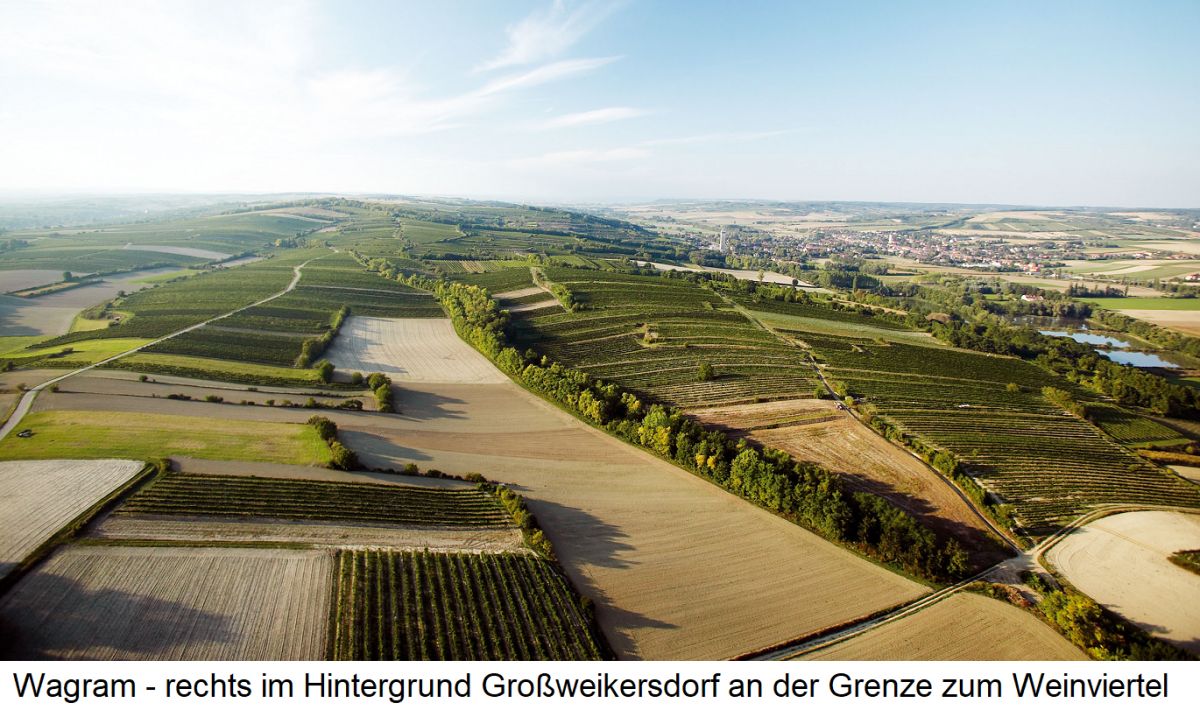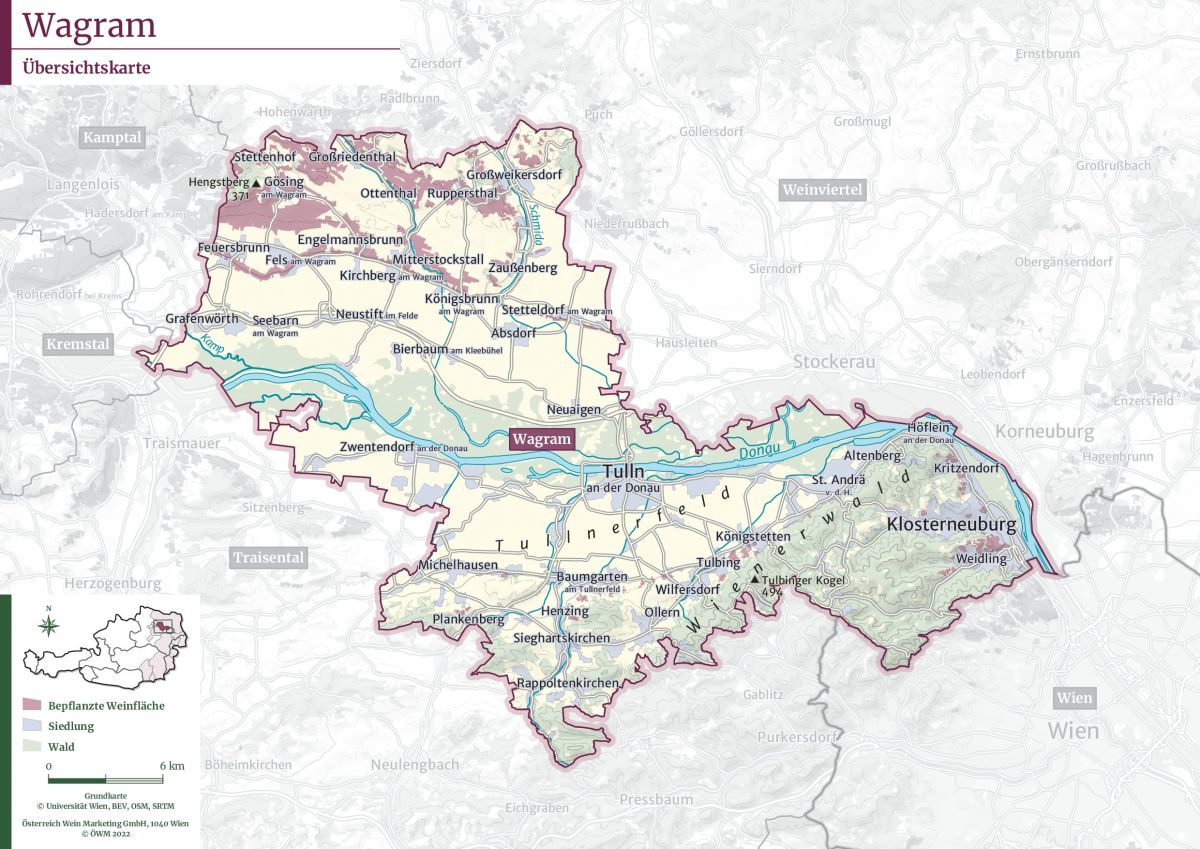One of the eight specific wine-growing areas in the Austrian province or generic wine-growing region of Lower Austria. From 1995 to 2007 it was called Donauland, but this confusing name never caught on because the Danube also flows through other wine-growing areas. The new name Wagram became valid from the 2007 vintage. The soil elevation north of the Danube that gives the area its name stretches from Feuersbrunn in the west to Heldenberg in the northeast.

Climate & Soils
The name (Wachrain) is derived from "Wogenrain" or "Wogenrand", which was the former edge of the Danube in the Tullner Feld during the last Ice Age. On a base of primary rock lies a spring horizon of marine sand, above which loess piles up to twelve metres high. The yellow soil has a high water storage capacity and produces multi-layered wines. The climate is different in the two sub-areas of Wagram and Klosterneuburg; see below.
Winegrowing area (sub-areas Wagram and Klosterneuburg)
The Wagram winegrowing area consists of two areas separated by the Danube. To the north and along the river stretches the much larger area mentioned above between the two wine-growing areas of Kamptal in the west and Vienna in the east. It also gave the name to the wine-growing region and covers around 2,100 hectares of vineyards. Well-known wine-growing communities are Fels am Wagram (with the vineyards Fumberg, Hammergraben, Mitterweg, Schafberg, Weelfel, Wora); Grafenwörth (Am Berg, Kellerweingarten, Nußberg and Rosenberg); Großriedenthal (Alter Weingarten, Eisenhut and Goldberg); Großweikersdorf as well as Kirchberg am Wagram (Hundsberg, Schlossberg and Steinberg).

East of this and south of the Danube lies the second part named after the town Klosterneuburg, including the town of Tulln and the municipality of Atzenbrugg. When the wine-growing area was renamed from Donauland to Wagram, this area was given the status of Großlage. The vineyards of this much smaller part cover about 350 hectares of vineyards. The cadastral communities of Höflein, Kierling, Kritzendorf, Maria Gugging, Weidling and Weidlingbach belong to Klosterneuburg. Well-known vineyards are Franzhauser, Weidling, Wieden and Ziegelgrub. The climate is characterised by the influence of the Danube, the protection against cold northern air by the foothills of the Manhartsberg and the nearby Pannonian region.
Grape variety list
In 2022, the vineyards covered a total of 2,459 hectares of vines. Compared to 2015 with 2,720 hectares, this was a reduction of 261 hectares (9.6%). The share of white wine varieties is 82%, the share of red wine varieties 18%. It is dominated with more than half of the stock Grüner Veltliner, followed by Zweigelt, Riesling, Müller-Thurgau and Roter Veltiner.
Grape variety
|
in Austria
|
Colour |
HA
|
%
|
HA
|
%
|
| Grüner Veltliner | Weißgipfler | white | 1.334 | 54,2 | 1.331 | 48,9 |
| Zweigelt | Blue Zweigelt, Rotburger | red | 303 | 12,3 | 373 | 13,7 |
| White Riesling | Riesling, Rhine Riesling | white | 135 | 5,5 | 134 | 4,9 |
| Müller-Thurgau | Rivaner | white | 105 | 4,3 | 171 | 6,3 |
| Roter Veltliner | - | white | 102 | 4,1 | 83 | 3,0 |
| White Burgundy | Pinot Blanc, Klevner | white | 62 | 2,5 | 76 | 2,8 |
| Frühroter Veltliner | Malvasia | white | 55 | 2,2 | 77 | 2,8 |
| Chardonnay | Morillon - not used in Lower Austria | white | 49 | 2,0 | 56 | 2,1 |
| Muscat Blanc | Yellow M., Red M. / Muscat Blanc | white | 38 | 1,5 | 31 | 1,1 |
| Blauburger | - | red | 31 | 1,3 | 55 | 2,0 |
| Sauvignon Blanc | Muscat Sylvaner | white | 28 | 1,1 | 23 | 0,8 |
| Pinot Noir, Pinot Noir | Pinot Noir, Pinot Noir, Pinot Noir | red | 25 | 1,0 | 27 | 1,0 |
| Welschriesling | - | white | 18 | 0,7 | 25 | 0,9 |
| St. Laurent | - | red | 18 | 0,7 | 19 | 0,7 |
| Cabernet Sauvignon | - | red | 17 | 0,7 | 18 | 0,7 |
| Blue Portugieser | - | red | 13 | 0,5 | 34 | 1,2 |
| Merlot | - | red | 10 | 0,4 | 9,5 | 0,4 |
| Roesler | - | red | 9,4 | 0,4 | 8,6 | 0,3 |
| Traminer | Gewürztraminer, Red T., Yellow T. | white | 9 | 0,4 | 13,2 | 0,5 |
| Blaufränkisch | - | red | 4 | 0,2 | 4,0 | 0,1 |
| Grey Burgundy | Pinot Gris, Ruländer | white | 3,4 | 0,1 | 1,8 | 0,1 |
| Neuburger | - | white | 3,2 | 0,1 | 5,0 | 0,2 |
| Flower muscatel | - | white | 3,2 | 0,1 | - | - |
| Syrah | Shiraz | red | 3 | 0,1 | 3,6 | 0,1 |
| Muscat Ottonel | - | white | 2,8 | 0,1 | 4,7 | 0,2 |
| Sylvaner | Green Sylvaner | white | 2,5 | 0,1 | 4,3 | 0,2 |
| Scheurebe | seedling 88 | white | 2,5 | 0,1 | 4,3 | 0,2 |
| Muscaris | - | white | 1,8 | 0,1 | - | - |
| Souvignier gris | - | white | 1,7 | 0,1 | - | - |
| Bouvier | - | white | 1,5 | 0,1 | 4,1 | 0,2 |
| Cabernet Franc | - | red | 1,5 | 0,1 | 1,1 | - |
| Rathay | - | red | 0,7 | - | 1,7 | 0,1 |
| Goldburger | - | white | 0,5 | - | 0,9 | - |
| Gold muscatel | - | white | 0,5 | - | - | - |
| Furmint | - | white | 0,4 | - | - | - |
| Blue Wildbacher | - | red | 0,4 | - | 0,7 | - |
| Zierfandler | late red | white | 0,3 | - | 1,0 | - |
| Rotgipfler | - | white | 0,1 | - | 0,1 | - |
| Jubilee Vine | - | white | 0,1 | - | - | - |
| Rose muscatel | - | white | 0,1 | - | - | - |
| remaining varieties | - | white | 66 | 2,7 | 122 | 4,5 |
WHITE SORT |
|
white |
2.012 |
82 |
2.134 |
79 |
RED SORT |
|
red |
447 |
18 |
586 |
21 |
TOTAL |
|
|
2.459 |
|
2.720 |
|
DAC system
In February 2022, the origin-controlled quality level Wagram DAC was introduced as of vintage 2021. All other quality wines are to be marketed with the origin Lower Austria, the regional wines under the winegrowing region designation Weinland. In addition to the generally valid DAC conditions, special rules apply. The pyramid of origin is divided into the levels " Gebietswein", " Ortswein " and " Riedenwein". In principle, hand harvesting is mandatory for all wines.

For the regional wines, 13 white wine varieties and 3 red wine varieties are permitted (see above in the diagram). Also possible are Gemischter Satz and cuvées. For the local wines there are 27 protected local varieties. Seven grape varieties are permitted, which must be vinified as single varietals (no rosé or white pressed). At the top of the quality pyramid are the single vineyard wines from individual, legally defined cultivation sites. The leading Wagram varieties Grüner Veltliner, Roter Veltliner and Riesling are permitted. All wines must comply with the specification dry; the white wines must not show a dominant wood tone.
Producers
Well-known producers are Arkadenhof Hausdorf, Bauer Anton, Bauer Josef, Bauer Naturnaher Weinbau, Bauer Stefan, Bayer Franz, Blauensteiner Leopold, BRÜNDY, Diwald Martin, Ecker - Eckhof, Ehmoser Josef, Ernst Harald, Fritsch Karl, Fritz Josef, Gerhold Rainer, Greil Norbert, Güntschl Ludwig, Hanauer Hof, Heiderer-Mayer, Kolkmann, Leth Franz, Mayer Franz Anton, Mehofer - Neudeggerhof, Ott Bernhard, Polsterer Andreas, Reinberger Alfred, Salomon Fritz, Sauerstingl, Schloss Fels, Schneider Franz, Schuster Karl, Söllner, Stift Klosterneuburg, Urbanihof Fam. Paschinger, Waldschütz Anton, Weinhof Grill, Wimmer-Czerny, Wöber Josef and Zimmermann Rudolf. Two well-known winegrowers' associations are Wagramer Selektion and Weingüter Wagram.
Voices of our members

As honorary chairman of the Domäne Wachau, it is the easiest and quickest way for me to access the wein.plus encyclopaedia when I have questions. The certainty of receiving well-founded and up-to-date information here makes it an indispensable guide.
Hans-Georg Schwarz
Ehrenobmann der Domäne Wachau (Wachau)